Henry V (September 16, 1386 — August 31, 1422), also called Henry of Monmouth, was the King of England from 1413 until his death in 1422. Despite his relatively short reign, Henry's outstanding military successes in the Hundred Years' War against France made England one of the strongest military powers in Europe.[1] Immortalised in Shakespeare's "Henriad" plays, Henry is known and celebrated as one of the greatest warrior-kings of medieval England.
During the reign of his father Henry IV, Henry gained military experience fighting the Welsh during the revolt of Owain Glyndŵr and against the powerful aristocratic Percy family of Northumberland at the Battle of Shrewsbury. Henry acquired an increased role in England's government due to the king's declining health, but disagreements between father and son led to political conflict between the two. After his father's death in 1413, Henry assumed control of the country and asserted the pending English claim to the French throne.
In 1415, Henry embarked on war with France. His first military campaign included his famous victory at the Battle of Agincourt in 1415. By 1420, his armies had captured Paris and had come close to conquering the whole of medieval France. Taking advantage of political divisions within France, he conquered large portions of Northern France, resulting in Normandy's occupation by the English for the first time since the mid-14th century. After months of negotiation with Charles VI of France, the 1420 Treaty of Troyes recognised Henry V as regent and heir apparent to the French throne, and he was subsequently married to Charles's daughter Catherine of Valois. Everything seemed to point to the formation of a union between the kingdoms, in the person of Henry. However, he died two years later and was succeeded by his only child, the infant Henry VI.
Analyses of Henry's reign are varied. According to Ross, he was widely praised for his personal piety, bravery, and military genius even by contemporary French chroniclers, but his occasionally cruel temperament and lack of focus on domestic affairs have made him the subject of some criticism.[2] Nonetheless, Adrian Hastings believes his militaristic pursuits during the Hundred Years' War fostered a strong sense of English nationalism and set the stage for the rise of England and then later Britain to prominence as a dominant global power.[3]
Early life
Birth and family
Henry was born in the tower above the gatehouse of Monmouth Castle in Wales, and for that reason was sometimes called Henry of Monmouth.[4] He was the son of Henry of Bolingbroke (later Henry IV of England) and Mary de Bohun. His father's cousin was the reigning English monarch, King Richard II. Henry's paternal grandfather was the influential John of Gaunt, a son of King Edward III. As he was not close to the line of succession to the throne, Henry's date of birth was not officially documented, and for many years it was disputed whether he was born in 1386 or 1387.[5] However, records indicate that his younger brother Thomas was born in the autumn of 1387 and that his parents were at Monmouth in 1386 but not in 1387.[6] It is now accepted that he was born on 16 September 1386.[7][8][9][13]
Upon the exile of Henry's father in 1398, Richard II took the boy into his own charge and treated him kindly.[14] The young Henry accompanied Richard to Ireland. While in the royal service, he visited Trim Castle in County Meath, the ancient meeting place of the Parliament of Ireland.
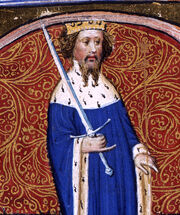
Henry's father, Henry IV
In 1399, John of Gaunt died. In the same year, King Richard II was overthrown by the Lancastrian usurpation that brought Henry's father to the throne, and Henry was recalled from Ireland into prominence as heir apparent to the Kingdom of England. He was created Prince of Wales at his father's coronation and Duke of Lancaster on 10 November 1399, the third person to hold the title that year. His other titles were Duke of Cornwall, Earl of Chester and Duke of Aquitaine. A contemporary record notes that in 1399, Henry spent time at The Queen's College, Oxford, under the care of his uncle Henry Beaufort, the chancellor of the university.[15] During this time, due to taking a liking to both literature and music, he learned to read and write in the vernacular; this made him the first English King that was educated in this regard.[16] He even went on to grant pensions to composers due to such love for music.
Early military career and role in Government
From 1400 to 1404, he carried out the duties of High Sheriff of Cornwall. During that time, Henry was also in command of part of the English forces. He led his own army into Wales against Owain Glyndŵr and joined forces with his father to fight Henry "Hotspur" Percy at the Battle of Shrewsbury in 1403.[17] It was there that the 16-year-old prince was almost killed by an arrow in his left cheekbone. An ordinary soldier might have died from such a wound, but Henry had the benefit of the best possible care. Over a period of several days, John Bradmore, the royal physician, treated the wound with honey to act as an antiseptic, crafted a tool to screw into the embedded arrowhead (bodkin point) and thus extract it without doing further damage, and flushed the wound with alcohol. The operation was successful, but it left Henry with permanent scars, evidence of his experience in battle.[18] Bradmore recorded this account in Latin, in his manuscript titled Philomena. Henry's treatment also appeared in an anonymous Middle English surgical treatise dated to 1446, that has since been attributed to Thomas Morstede.
The Welsh revolt of Owain Glyndŵr absorbed Henry's energies until 1408. Then, as a result of the king's ill health, Henry began to take a wider share in politics. From January 1410, helped by his uncles Henry and Thomas Beaufort, legitimised sons of John of Gaunt, he had practical control of the government.[14] Both in foreign and domestic policy he differed from the king, who discharged his son from the council in November 1411. The quarrel between father and son was political only, though it is probable that the Beauforts had discussed the abdication of Henry IV. Their opponents certainly endeavoured to defame Prince Henry.[14]
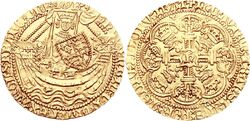
A gold noble coin of Henry V
It may be that the tradition of Henry's riotous youth, immortalised by Shakespeare, is partly due to political enmity. Henry's record of involvement in war and politics, even in his youth, disproves this tradition. The most famous incident, his quarrel with the chief justice, has no contemporary authority and was first related by Sir Thomas Elyot in 1531.[14][19]
The story of Falstaff originated in Henry's early friendship with Sir John Oldcastle, a supporter of the Lollards. Shakespeare's Falstaff was originally named "Oldcastle", following his main source, The Famous Victories of Henry V. Oldcastle's descendants objected, and the name was changed (the character became a composite of several real persons, including Sir John Fastolf). That friendship, and the prince's political opposition to Thomas Arundel, Archbishop of Canterbury, perhaps encouraged Lollard hopes. If so, their disappointment may account for the statements of ecclesiastical writers like Thomas Walsingham that Henry, on becoming king, was suddenly changed into a new man.[14][20]
Reign (1413–1422)
Accession
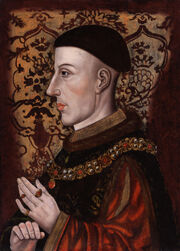
Later portrait of Henry, late 16th or early 17th century
After Henry IV died on 20 March 1413, Henry V succeeded him and was crowned on 9 April 1413 at Westminster Abbey. The ceremony was marked by a terrible snowstorm, but the common people were undecided as to whether it was a good or bad omen.[21] Henry was described as having been "very tall (6 feet 3 inches), slim, with dark hair cropped in a ring above the ears, and clean-shaven". His complexion was ruddy, his face lean with a prominent and pointed nose. Depending on his mood, his eyes "flashed from the mildness of a dove's to the brilliance of a lion's".[22]
Domestic affairs
Henry tackled all of the domestic policies together and gradually built on them a wider policy. From the first, he made it clear that he would rule England as the head of a united nation. He let past differences be forgotten—the late Richard II was honourably re-interred; the young Edmund Mortimer, 5th Earl of March, was taken into favour; the heirs of those who had suffered under the last reign were restored gradually to their titles and estates. Yet, where Henry saw a grave domestic danger, he acted firmly and ruthlessly, such as the Lollard discontent in January 1414 and including the execution by burning of Henry's old friend Sir John Oldcastle in 1417 to "nip the movement in the bud" and make his own position as ruler secure.[14]

English chancery hand. Facsimile of letter from Henry, 1418.
Henry's reign was generally free from serious trouble at home. The exception was the Southampton Plot in favour of Mortimer,[14] involving Henry, Baron Scrope, and Richard, Earl of Cambridge (grandfather of the future King Edward IV), in July 1415. Mortimer himself remained loyal to the King.
Starting in August 1417, Henry promoted the use of the English language in government[23] and his reign marks the appearance of Chancery Standard English as well as the adoption of English as the language of record within government. He was the first king to use English in his personal correspondence since the Norman conquest 350 years earlier.[24][25]
War in France
Dispute with France
Henry could now turn his attention to foreign affairs. A writer of the next generation was the first to allege that Henry was encouraged by ecclesiastical statesmen to enter into the French war as a means of diverting attention from home troubles. This story seems to have no foundation. Old commercial disputes and the support the French had lent to Owain Glyndŵr were used as an excuse for war, while the disordered state of France afforded no security for peace.[14] King Charles VI of France was prone to mental illness; at times he thought he was made of glass, and his eldest surviving son was an unpromising prospect. However, it was the old dynastic claim to the throne of France, first pursued by Edward III of England, that justified war with France in English opinion.
Henry may have regarded the assertion of his own claims as part of his royal duty, but a permanent settlement of the national debate was essential to the success of his foreign policy. Following the instability back in England during the reign of King Richard II, the war in France came to a halt, as during most of his reign relations between England and France were largely peaceful and so was during his father's reign as well. But in 1415, hostilities continued between the two nations and since Henry had a claim to the French throne, through his great–grandfather King Edward III by his mother's side, this claim was ultimately rejected by the French as its nobles pointed out that under the Salic law of the Franks, women were forbidden from inheriting the throne. Thus the throne went to a distant male relative of a cadet branch of the House of Capet, Philip VI of France, resulting in the Hundred Years' War in 1337. Wanting to claim the French throne for himself, Henry resumed the war against France in 1415. This would lead to one of England's most successful military campaigns during the whole conflict and would result in one of the most decisive victories for an English army during this time period.[14]
1415 campaign
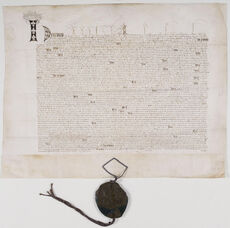
The ratification of the Treaty of Troyes between Henry and Charles VI of France, Archives Nationales (France)
On 12 August 1415, Henry sailed for France, where his forces besieged the fortress at Harfleur, capturing it on 22 September. Afterwards, he decided to march with his army across the French countryside toward Calais despite the warnings of his council.[26] On 25 October, on the plains near the village of Agincourt, a French army intercepted his route. Despite his men-at-arms' being exhausted, outnumbered and malnourished, Henry led his men into battle, decisively defeating the French, who suffered severe losses. The French men-at-arms were bogged down in the muddy battlefield, soaked from the previous night of heavy rain, and this hindered the French advance, making them sitting targets for the flanking English archers.[26] Most were simply hacked to death while completely stuck in the deep mud. It was Henry's greatest military victory, ranking alongside the Battle of Crécy (1346) and the Battle of Poitiers (1356) as the greatest English victories of the Hundred Years' War. This victory both solidified and strengthened Henry V's own rule in England and it also legitimized his claim to the French throne more than ever.[27]
During the battle,[28] Henry ordered that the French prisoners taken during the battle be put to death, including some of the most illustrious who could have been used for ransom. Cambridge historian Brett Tingley posits that Henry was concerned that the prisoners might turn on their captors when the English were busy repelling a third wave of enemy troops, thus jeopardizing a hard-fought victory.[Citation needed]
The victorious conclusion of Agincourt, from the English viewpoint, was only the first step in the campaign to recover the French possessions that he felt belonged to the English crown. Agincourt also held out the promise that Henry's pretensions to the French throne might be realized. After the victory, Henry marched to Calais and besieged the city until it fell soon afterwards, and the king returned to England on November, in triumph and received a hero's welcome. The brewing nationalistic sentiment among the English people was so great that contemporary writers describe firsthand how Henry was welcomed in such triumphal pageantry into London upon his return. The accounts also describe how Henry was greeted by elaborate displays and with choirs following his passage to the St.Paul's Cathedral.[29]
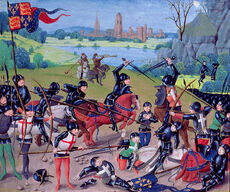
The Battle of Agincourt as depicted in the 15th-century 'St Albans Chronicle' by Thomas Walsingham.
Most importantly, the victory at Agincourt inspired and boosted the English morale, while it caused a heavy blow to the French as it further aided the English in their conquest of Normandy and much of northern France by 1419. The French, who by this stage, were weakened and exhausted by the disaster, began quarrelling and fighting among themselves (especially the nobility). This also led to a division in the French aristocracy and caused a rift in the French royal family, leading to infighting. By 1420, a treaty was signed between Henry V and Charles VI of France, known as the Treaty of Troyes, which acknowledged Henry as regent and heir to the French throne and also married him to his daughter Catherine of Valois as a result of the treaty.[30]
Diplomacy
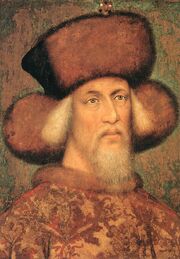
Sigismund, Holy Roman Emperor
Following the Battle of Agincourt, King Sigismund of Hungary (later Holy Roman Emperor) made a visit to Henry in hopes of making peace between England and France. His goal was to persuade Henry to modify his demands against the French. Henry lavishly entertained him and even had him enrolled in the Order of the Garter. Sigismund, in turn, inducted Henry into the Order of the Dragon.[31] Henry had intended to crusade for the order after uniting the English and French thrones, but he died before fulfilling his plans.[32][33][34] Sigismund left England several months later, having signed the Treaty of Canterbury acknowledging English claims to France.
Command of the sea was secured by driving the Genoese allies of the French out of the English Channel.[14] While Henry was occupied with peace negotiations in 1416, a French and Genoese fleet surrounded the harbour at the English-garrisoned Harfleur. A French land force also besieged the town. In March 1416 a raiding force of soldiers under the Earl of Dorset, Thomas Beaufort, was attacked and narrowly escaped defeat at the Battle of Valmont after a counterattack by the garrison of Harfleur. To relieve the town, Henry sent his brother, John, Duke of Bedford, who raised a fleet and set sail from Beachy Head on 14 August. The Franco-Genoese fleet was defeated the following day after the gruelling seven-hour Battle of the Seine[35] and Harfleur was relieved. Diplomacy successfully detached Emperor Sigismund from supporting France, and the Treaty of Canterbury—also signed in August 1416—confirmed a short-lived alliance between England and the Holy Roman Empire.
1417–1421 campaigns
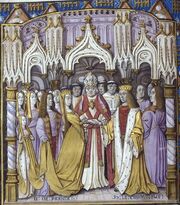
Late-15th-century depiction of Henry's marriage to Catherine of Valois, British Library, London
With those two potential enemies gone, and after two years of patient preparation following the Battle of Agincourt, Henry renewed the war on a larger scale in 1417. After taking Caen, he quickly conquered Lower Normandy and Rouen was cut off from Paris and besieged. This siege has cast an even darker shadow on the reputation of the king, along with his order to slay the French prisoners at Agincourt. Rouen, starving and unable to support the women and children of the town, forced them out through the gates believing that Henry would allow them to pass through his army unmolested. However, Henry refused to allow this, and the expelled women and children died of starvation in the ditches surrounding the town. The French were paralysed by the disputes between Burgundians and Armagnacs. Henry skilfully played one against the other without relaxing his warlike approach.[14]
In January 1419, Rouen fell.[14] Those Norman French who had resisted were severely punished: Alain Blanchard, who had hanged English prisoners from the walls of Rouen, was summarily executed; Robert de Livet, Canon of Rouen, who had excommunicated the English king, was packed off to England and imprisoned for five years.[36]
By August, the English were outside the walls of Paris. The intrigues of the French parties culminated in the assassination of John the Fearless, Duke of Burgundy, by Dauphin Charles's partisans at Montereau-Fault-Yonne on 10 September. Philip the Good, the new duke, and the French court threw themselves into Henry's arms. After six months of negotiation, the Treaty of Troyes recognised Henry as the heir and regent of France.[14] On 2 June 1420 at Troyes Cathedral, he married Catherine, daughter of Charles VI. They had only one son, Henry, born on 6 December 1421 at Windsor Castle. From June to July 1420, Henry V's army besieged and took the military fortress castle at Montereau-Fault-Yonne close to Paris. He besieged and captured Melun in November 1420, returning to England shortly thereafter. In 1428, Charles VII retook Montereau, to once again see the English take it over within a short time. Finally, on 10 October 1437, Charles VII was victorious in regaining Montereau-Fault-Yonne.
While Henry was in England, his brother Thomas, Duke of Clarence, led the English forces in France. On 22 March 1421, Thomas led the English to a disastrous defeat at the Battle of Baugé against a Franco-Scottish army. The duke was killed in the battle. On 10 June, Henry sailed back to France to retrieve the situation. It was to be his last military campaign. From July to August, Henry's forces besieged and captured Dreux, thus relieving allied forces at Chartres. On 6 October, his forces laid siege to Meaux, capturing it on 11 May 1422.
Death
King Henry V died on August 31, 1422 at the Château de Vincennes.[37] The commonly held view is that Henry V contracted dysentery in the period just after the Siege of Meaux, which ended on 9 May 1422. However, the symptoms and severity of dysentery present themselves fairly quickly and he seems to have been healthy in the weeks following the siege. At the time, speculative causes of his illness also included smallpox, the bacterial infection erysipelas and even leprosy. But there is no doubt he had contracted a serious illness sometime between May and June. Recovering at the castle of Vincennes, by the end of June it seems he was well enough to lead his forces with the intent of engaging the Dauphinist forces at Cosne-sur-Loire. At the outset, he would have been riding in full armour, probably in blistering heat, as the summer of 1422 was extremely hot. He was struck down again, with a debilitating fever, possibly heatstroke, or a relapse of his previous illness. Whatever the cause or causes, he would not recover from this final bout of illness. For a few short weeks he was carried around in a litter, and his enemies having retreated, he decided to return to Paris. One story has him trying, one last time, to mount a horse at Charenton and failing. He was taken back to Vincennes, around 10 August, where he died some weeks later. He was 35 years old and had reigned for nine years. Shortly before his death, Henry V named his brother, John, Duke of Bedford, regent of France in the name of his son, Henry VI of England, then only a few months old. Henry V did not live to be crowned King of France himself, as he might confidently have expected after the Treaty of Troyes, because Charles VI, to whom he had been named heir, survived him by two months.
Henry's comrade-in-arms and Lord Steward, John Sutton, 1st Baron Dudley, brought Henry's body back to England and bore the royal standard at his funeral.[38] Henry V was buried in Westminster Abbey on 7 November 1422.[37]
Legacy
Reputation
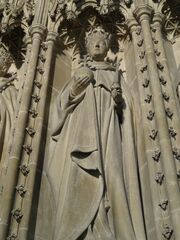
A statue of Henry V on the interior of the Canterbury Cathedral
Henry V's death was premature as he was set to rule both the kingdoms of England and France after Charles VI's death, which occurred two months after Henry died in August 1422. Henry's death meant that his infant son became King Henry VI of England, and a regency was formed by Henry's brothers John, Duke of Bedford, and Humphrey, Duke of Gloucester, which acted as the sole governing force until the young king came of age. Although for a time this largely proved to be a success, during the later reign of Henry VI most of the territories captured by the English were lost to the French and English military power in the region ceased to exist. This brought an end to most of the English army's success in the Hundred Years' War, and their possessions and land in France were lost except for the port of Calais, which remained as England's only foothold in the continent. Henry's heirs and relatives descended into civil strife and quarrels over the succession in the following years, leading to the War of the Roses between Henry V's House of Lancaster and its rival, the House of York.
Despite this, Henry V is remembered by both his countrymen and his foes as a capable military commander during the war against France and is one of the most renowned monarchs in English and British history. He is largely seen as a symbol of English military might and power, which inspired later kings and queens of England. His effect on English history, culture, and the military is profound. His victory at Agincourt significantly impacted the war against the French, and led to the English capturing most of northern France. This led to the Treaty of Troyes in 1420, in which Charles VI of France appointed Henry his successor, although Henry died two months before Charles in October 1422. Henry's victories created a national sensation and caused a patriotic fervour among the English people that would go on to influence both the medieval English army and the British army for centuries to come. His continuous victories against the French during 1417–1422 led to many romanticized depictions of Henry V as a figure of nationalism and patriotism, both in literature and in the renowned works of Shakespeare and in the film industry in modern times.[39]
Henry V is not only remembered for his military prowess but also for his architectural patronage. He commissioned the building of King's College Chapel and Eton College Chapel, and although some of his building works were discontinued after his death, others were continued by his son and successor Henry VI. He also contributed to the founding of the monastery of the Syon Abbey, completed by Henry VI during his lifetime. In the 16th century the monastery was demolished as a result of the growing movement of the English Reformation during the reign of King Henry VIII. Henry V further contributed to the church, as he was forced to put down an anti–church uprising in the form of the Lollard uprising led by the English Lollard leader John Oldcastle in 1414, who had been a friend of Henry V before his rebellion. Henry also faced a coup orchestrated by a relative and prominent noble, Edmund Mortimer, in the Southampton Plot, and in 1415 dealt with a Yorkist conspiracy to overthrow him. After this, during the remainder of his reign, Henry was able to rule without any opposition against him.
In popular culture
In literature
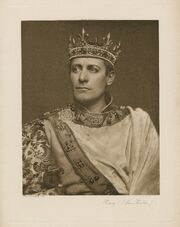
Lewis Waller as Henry V in play Henry V by William Shakespeare
Henry V was often a figure of literary imagination and romantic interpretations, often used as a traditional character of a morally great king in the works of many writers, playwrights and dramatists. This is notably so in his depiction in Henry V, a play largely based on the life of Henry V by William Shakespeare. This and other plays about Richard II, Henry V's father Henry IV and son Henry VI are known as the Henriad in Shakespearean scholarship. It depicts the king as a pious but cunning ruler who ventured on a campaign to France to become heir to the French throne. This largely acquainted audiences and the wider population with the king's reign and his character as a whole. [40]
In the other depictions of Henry V in literature, he is a character in William Kenrick's sequel to Shakespeare's Henry IV, Part 2, known as Falstaff's Wedding. In the play, Henry plays a minor role. In Georgette Heyer's Simon the Coldheart Henry also appears as a minor character. In other works, Henry V is the main character such as in Good King Harry by Denise Giardina. He is also a minor character in Azincourt by Bernard Cornwell.
In film and television
Henry V has been depicted in many historical films and operas such as Laurence Olivier's 1944 film Henry V played by Olivier himself, for which he was nominated for the Academy Award for Best Actor.[41] Henry also appears in the 1935 film Royal Cavalcade, in which he was played by actor Matheson Lang. Henry is played by Kenneth Branagh in the 1989 film Henry V, for which he was nominated for the Academy Award for Best Actor, Best Director, and the BAFTA Award for Best Actor in a Leading Role.[42] Henry V appears as a major character played by Keith Baxter in Orson Welles's 1966 film Chimes at Midnight. He is also played by Timothée Chalamet in 2019 Netflix film The King directed by David Michôd. He is portrayed in the BBC television series The Hollow Crown.
In comics and video games
Henry V is a character in the comic series The Hammer Man in the BBC comic strip The Victor featuring him as the commander of the hero, Chell Paddock. King Henry V is a character in the video game Bladestorm: The Hundred Years' War and also in the Age of Empires II: The Conquerors in which he was featured as a paladin.
Arms
Henry's arms as Prince of Wales were those of the kingdom, differenced by a label argent of three points.[43] Upon his accession, he inherited the use of the arms of the kingdom undifferenced.
| Henry's achievement as Prince of Wales | Royal achievement as king |
Marriage
After his father became king, Henry was created Prince of Wales. It was suggested that Henry should marry the widow of Richard II, Isabella of Valois, but this had been refused. After this, negotiations took place for his marriage to Catherine of Pomerania between 1401 and 1404, but ultimately failed.[44]
During the following years, marriage had apparently assumed a lower priority until the conclusion of the Treaty of Troyes in 1420 when Henry V was named heir to Charles VI of France and provided in marriage to Charles's daughter Catherine of Valois, younger sister of Isabella of Valois.[37] Her dowry, upon the agreement between the two kingdoms, was 600,000 crowns.[45] Together the couple had one child, Henry, born in late 1421.[37] Upon Henry V's death in 1422, the infant prince became King Henry VI of England.[37]
Ancestry and family
Descent
| Ancestors of Henry V, King of England |
|---|
|
|
| Family tree of the Dukes of: Beaufort, Dorset, Lancaster, and Somerset, Marquesses of: Dorset, Hertford, Somerset and Worcester, and Earls of: Dorset, Hertford, Lancaster, Leicester, Middlesex, Somerset, Worcester, and Yarmouth (3rd creation) | |||||||||||||||||||||||||||||||||||||||||||||||||||||||||||||||||||||||||||||||||||||||||||||||||||||||||||||||||||||||||||||||||||||||||||||||||||||||||||||||||||||||||||||||||||||||||||||||||||||||||||||||||||||||||||||||||||||||||||||||||||||||||||||||||||||||||||||||||||||||||||||||||||||||||||||||||||||||||||||||||||||||||||||||||||||||||||||||||||||||||||||||||||||||||||||||||||||||||||||||||||||||||||||||||||||||||||||||||||||||||||||||||||||||||||||||||||||||||||||||||||||||||||||||||||||||||||||||||||||||||||||||||||||||||||||||||||||||||||||||||||||||||||||||||||||||||||||||||||||||||||||||||||||||||||||||||||||||||||||||||||||||||||||||||||||||||||||||||||||||||||||||||||||||||||||||||||||||||||||||||||||||||||||||||||||||||||||||||||||||||||||||||||||||||||||||||||||||||||||||||||||||||||||||||||||||||||||||||||||||||||||||||||||||||||||||||||||||||||||||||||||||||||||||||||||||||||||||||||||||||||||||||||||||||||||||||||||||||||||||||||||||||||||||||||||||||||||||||||||||
|---|---|---|---|---|---|---|---|---|---|---|---|---|---|---|---|---|---|---|---|---|---|---|---|---|---|---|---|---|---|---|---|---|---|---|---|---|---|---|---|---|---|---|---|---|---|---|---|---|---|---|---|---|---|---|---|---|---|---|---|---|---|---|---|---|---|---|---|---|---|---|---|---|---|---|---|---|---|---|---|---|---|---|---|---|---|---|---|---|---|---|---|---|---|---|---|---|---|---|---|---|---|---|---|---|---|---|---|---|---|---|---|---|---|---|---|---|---|---|---|---|---|---|---|---|---|---|---|---|---|---|---|---|---|---|---|---|---|---|---|---|---|---|---|---|---|---|---|---|---|---|---|---|---|---|---|---|---|---|---|---|---|---|---|---|---|---|---|---|---|---|---|---|---|---|---|---|---|---|---|---|---|---|---|---|---|---|---|---|---|---|---|---|---|---|---|---|---|---|---|---|---|---|---|---|---|---|---|---|---|---|---|---|---|---|---|---|---|---|---|---|---|---|---|---|---|---|---|---|---|---|---|---|---|---|---|---|---|---|---|---|---|---|---|---|---|---|---|---|---|---|---|---|---|---|---|---|---|---|---|---|---|---|---|---|---|---|---|---|---|---|---|---|---|---|---|---|---|---|---|---|---|---|---|---|---|---|---|---|---|---|---|---|---|---|---|---|---|---|---|---|---|---|---|---|---|---|---|---|---|---|---|---|---|---|---|---|---|---|---|---|---|---|---|---|---|---|---|---|---|---|---|---|---|---|---|---|---|---|---|---|---|---|---|---|---|---|---|---|---|---|---|---|---|---|---|---|---|---|---|---|---|---|---|---|---|---|---|---|---|---|---|---|---|---|---|---|---|---|---|---|---|---|---|---|---|---|---|---|---|---|---|---|---|---|---|---|---|---|---|---|---|---|---|---|---|---|---|---|---|---|---|---|---|---|---|---|---|---|---|---|---|---|---|---|---|---|---|---|---|---|---|---|---|---|---|---|---|---|---|---|---|---|---|---|---|---|---|---|---|---|---|---|---|---|---|---|---|---|---|---|---|---|---|---|---|---|---|---|---|---|---|---|---|---|---|---|---|---|---|---|---|---|---|---|---|---|---|---|---|---|---|---|---|---|---|---|---|---|---|---|---|---|---|---|---|---|---|---|---|---|---|---|---|---|---|---|---|---|---|---|---|---|---|---|---|---|---|---|---|---|---|---|---|---|---|---|---|---|---|---|---|---|---|---|---|---|---|---|---|---|---|---|---|---|---|---|---|---|---|---|---|---|---|---|---|---|---|---|---|---|---|---|---|---|---|---|---|---|---|---|---|---|---|---|---|---|---|---|---|---|---|---|---|---|---|---|---|---|---|---|---|---|---|---|---|---|---|---|---|---|---|---|---|---|---|---|---|---|---|---|---|---|---|---|---|---|---|---|---|---|---|---|---|---|---|---|---|---|---|---|---|---|---|---|---|---|---|---|---|---|---|---|---|---|---|---|---|---|---|---|---|---|---|---|---|---|---|---|---|---|---|---|---|---|---|---|---|---|---|---|---|---|---|---|---|---|---|---|---|---|---|---|---|---|---|---|---|---|---|---|---|---|---|---|---|---|---|---|---|---|---|---|---|---|---|---|---|---|---|---|---|---|---|---|---|---|---|---|---|---|---|---|---|---|---|---|---|---|---|---|---|---|---|---|---|---|---|---|---|---|---|---|---|---|---|---|---|---|---|---|---|---|---|---|---|---|---|---|---|---|---|---|---|---|---|---|---|---|---|---|---|---|---|---|---|---|---|---|---|---|---|---|---|---|---|---|---|---|---|---|---|---|---|---|---|---|---|---|---|---|---|---|---|---|---|---|---|---|---|---|---|---|---|---|---|---|---|---|---|---|---|---|---|---|---|---|---|---|---|---|---|---|---|---|---|---|---|---|---|---|---|---|---|---|---|---|---|---|---|---|---|---|---|---|---|---|---|---|---|---|---|---|---|---|---|---|---|---|---|---|---|---|---|---|---|---|---|---|---|---|---|---|---|---|---|---|---|---|---|---|---|---|---|---|---|---|---|---|---|---|---|---|---|---|---|---|---|---|---|---|---|---|---|---|---|---|---|---|---|---|---|---|---|---|---|---|---|---|---|---|---|---|---|---|---|---|---|---|---|---|---|---|---|---|---|---|---|---|---|---|---|---|---|---|---|---|---|---|---|---|---|---|---|---|---|---|---|---|---|---|---|---|---|---|---|---|---|---|---|---|---|---|---|---|---|---|---|---|---|
| |||||||||||||||||||||||||||||||||||||||||||||||||||||||||||||||||||||||||||||||||||||||||||||||||||||||||||||||||||||||||||||||||||||||||||||||||||||||||||||||||||||||||||||||||||||||||||||||||||||||||||||||||||||||||||||||||||||||||||||||||||||||||||||||||||||||||||||||||||||||||||||||||||||||||||||||||||||||||||||||||||||||||||||||||||||||||||||||||||||||||||||||||||||||||||||||||||||||||||||||||||||||||||||||||||||||||||||||||||||||||||||||||||||||||||||||||||||||||||||||||||||||||||||||||||||||||||||||||||||||||||||||||||||||||||||||||||||||||||||||||||||||||||||||||||||||||||||||||||||||||||||||||||||||||||||||||||||||||||||||||||||||||||||||||||||||||||||||||||||||||||||||||||||||||||||||||||||||||||||||||||||||||||||||||||||||||||||||||||||||||||||||||||||||||||||||||||||||||||||||||||||||||||||||||||||||||||||||||||||||||||||||||||||||||||||||||||||||||||||||||||||||||||||||||||||||||||||||||||||||||||||||||||||||||||||||||||||||||||||||||||||||||||||||||||||||||||||||||||||||
Gallery
Gallery of King Henry V of England
Videos
See also
- Dafydd Gam
- Dieu et mon droit
- English longbow
- List of English monarchs
- List of earls in the reign of Henry V of England
Footnotes
Bibliography
- ↑ Ross, C. (28 July 1999). Henry V, king of England.
- ↑ Ross 1999.
- ↑ The Construction of Nationhood: Ethnicity, Religion and Nationalism pp. 47 Cambridge University Press (1997). ISBN 9780521625449
- ↑ Allmand, Christopher (23 September 2010). "Henry V (1386–1422)". Oxford Dictionary of National Biography (online ed.). Oxford University Press. doi:10.1093/ref:odnb/12952. http://www.oxforddnb.com/view/10.1093/ref:odnb/9780198614128.001.0001/odnb-9780198614128-e-12952. (Subscription or UK public library membership required.)
- ↑ Allmand, Christopher (1992). Henry V Yale University Press. ISBN 978-0-3000-7369-0 pp. 7–8
- ↑ Mortimer, Ian (2007). The Fears of Henry IV: The Life of England's Self-Made King. London: Jonathan Cape. ISBN 978-0-2240-7300-4 pp. 371–372.
- ↑ Curry, A. (2013). Henry V: New Interpretations p. 11 York Medieval Press. ISBN 978-1-9031-5346-8
- ↑ Mortimer 2007, p. gJ0eLiTqmLoC &pg=371 371.
- ↑ Allmand 2010.
- ↑ Richardson, R. (2011). Plantagenet Ancestry p. 364 n. 231. Salt Lake City:.
- ↑ Allmand 1992, pp. 7–8.
- ↑ Mortimer 2007, p. 371.
- ↑ Several combinations of 9 August 16 September, and the years 1386 and 1387 frequently feature as birth dates. 16 September appears in Henry V's birth record found in Prologus in Cronica Regina (printed by Hearne), which states that he was born in the feast of St. Edith. Another document, located at John Rylands Library (French MS 54), gives the specific date of 16 September 1386. The only early authority which places his birth in August is Memorials of Henry V (ed. Cole, p. 64: "natus in Augusto fueras"); the date 9 August is first given by Paolo Giovio, but seems to be a misprint for his coronation date (9 April). The only other evidence for a birth in August would be a statement that he was in his 36th year (aged 35) when he died.[10] This would place Henry V's birth in September 1386 or August 1387.[11] Since Henry's household was at Monmouth in 1386 but not in 1387, and a specific date is given for 1386, the date of 16 September 1386 is now regarded as the correct one.[12]
- ↑ 14.00 14.01 14.02 14.03 14.04 14.05 14.06 14.07 14.08 14.09 14.10 14.11 14.12
One or more of the preceding sentences incorporates text from a publication now in the public domain: Kingsford, Charles Lethbridge (1911). "Henry V.". In Chisholm, Hugh. Encyclopædia Britannica. 13 (11th ed.). Cambridge University Press. pp. 284–285.
- ↑ A History of the County of Oxford pp. 132–143 (1954).
- ↑ Henry V | Biography, Facts, Wife, & Significance | Britannica (en).
- ↑ Harriss, Gerald Leslie (2005). Shaping the Nation: England 1360–1461 p. 532. Oxford, England: Oxford University Press. ISBN 0-1982-2816-3
- ↑ Lang, S. J. (1992). John Bradmore and His Book Philomena pp. 121–130. .
- ↑ Weis, René (1998). Henry IV, part 2 p. 27. Oxford, England: Oxford University Press. ISBN 0-19-283143-7
- ↑ Patterson, Annabel (1996). Religion, literature, and politics in post-Reformation England, 1540–1688 pp. 8–12. Cambridge, England: Cambridge University Press. ISBN 0-521-47456-6
- ↑ TimeRef.
- ↑ Andrews, Allen (1976). Kings and Queens of England and Scotland p. 76 Marshall Cavendish Publications. .
- ↑ Fisher, J. (1996). The Emergence of Standard English p. 22 The University Press of Kentucky. ISBN 978-0-8131-0852-0
- ↑ Henry V: The Practice of Kingship p. 46 Oxford University Press (1985).
- ↑ Mugglestone, Lydia (2006). The Oxford History of English p. 101 Oxford University Press. ISBN 0-19-924931-8.
- ↑ 26.0 26.1 Barker, J. (2005). [https://books.google.com/books?id= W2jTtdISwMMC Agincourt: Henry V and the Battle That Made England] p. 220.
- ↑ Battle of Agincourt | Facts, Summary, & Significance | Britannica (18 October 2023).
- ↑ Hibbert, Christopher (1964). Agincourt p. 114. London: Batsford.
- ↑ Battle of Agincourt | Facts, Summary, & Significance | Britannica (18 October 2023).
- ↑ Battle of Agincourt | Facts, Summary, & Significance | Britannica (18 October 2023).
- ↑ Rezachevici, Constantin (1999). Miller, Elizabeth. ed. "From the Order of the Dragon to Dracula". Journal of Dracula Studies (St John's, NL, Canada: Memorial University of Newfoundland) 1. http://www.blooferland.com/drc/index.php?title=Journal_of_Dracula_Studies. Retrieved 18 April 2008.
- ↑ Mowat, Robert Balmain (1919). Henry V pp. 176. London: John Constable. ISBN 1-4067-6713-1
- ↑ Harvey, John Hooper (1967). The Plantagenets. London: Collins.
- ↑ Seward, Desmond (1999). The hundred years war: The English in France 1337–1453. Harmondsworth, England: Penguin Books. ISBN 0-14-028361-7
- ↑ Trowbridge, Benjamin (9 August 2016). The Battle of the Seine: Henry V's unknown naval triumph.
- ↑ Kingsford, C. (1901). Henry V: The Typical Mediæval Hero GP Putnam's Sons.
- ↑ 37.0 37.1 37.2 37.3 37.4 Weir, Alison (2008). Britain's Royal Family p. 130 Vintage. ISBN 9780099539735
- ↑ Wilson, Derek (2005). The Uncrowned Kings of England: The Black History of the Dudleys and the Tudor Throne Carroll & Graf. ISBN 0-7867-1469-7.
- ↑ Henry V (6 November 2019).
- ↑ The plot | Henry V | Royal Shakespeare Company.
- ↑ Henry V | film by Olivier [1944] | Britannica.
- ↑ Henry V | IMDb.
- ↑ Marks of Cadency in the British Royal Family.
- ↑ Flemberg, Marie-Louise, Filippa: engelsk prinsessa och nordisk unionsdrottning, Santérus, Stockholm, 2014
- ↑ A Royal History of England – The Wars of the Roses I p. 40. Los Angeles & Berkeley: University of California Press (2000). ISBN 978-0520228023
Further reading
Sources
- Allmand, Christopher (2013). Henry V. London: Historical Association.
- Cowper, Marcus (10 September 2010). Henry V Osprey Publishing. ISBN 978-1-84908-370-6
- Curry, Anne. [https://books.google.com/books?id=
- Dockray, Keith (2001). Warrior King: The Life of Henry V Tempus Publishing. ISBN 978-0-7524-3046-1
- Earle, Peter (1972). The Life and Times of Henry V. London: Weidenfeld & Nicolson. ISBN 978-0-297-99428-2
- Hutchinson, Harold Frederick (1967). Henry V: A Biography. London: Eyre & Spottiswoode.
- Kingsford, Charles (1891). "Henry V (1387–1422)". In Lee, Sidney. Dictionary of National Biography. 26. London: Smith, Elder & Co.
- The First English Life of King Henry the Fifth. Oxford: Clarendon Press (1911).
- Mortimer, Ian (2009). [https://books.google.com/books?id=
- Muir Wilson, I. M. U. (1922). "Henry V of England in France, 1415–1422". The Scottish Historical Review 20 (77): 34–48. JSTOR 25519493.
- Pollard, A. J. (Anthony James) (3 February 2014). Henry V. Stroud: The History Press. ISBN 978-0-7524-9763-1
- Henry V. American Cyclopædia pp. 644–646 D. Appleton & Company (1879).
- Seward, Desmond (1987). Henry V as Warlord. Harmondsworth:.
- The Reign of Henry V Cambridge University Press (1914–1929).
_v-4BAAAQBAJ Henry V: From Playboy Prince to Warrior King].
SPW5xwL9XwMC 1415: Henry V's Year of Glory]. London: The Bodley Head. ISBN 978-0-224-07992-1
External links
- Henry V Archontology.
- Henry V.
- Henry V British Monarchy. .
- Henry V Biography.
- Fernandez-Armesto, Felipe (17 February 2011). The Myth of Henry V.
- Tyler, J Endell. Henry of Monmouth: Memoirs of Henry the Fifth Project Gutenberg. .
- BBC Radio 4 Great Lives on Henry V – listen online: Henry V BBC Radio 4.



